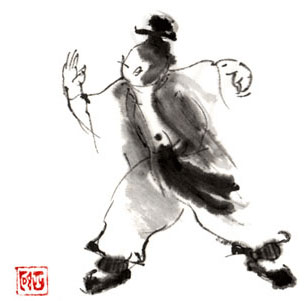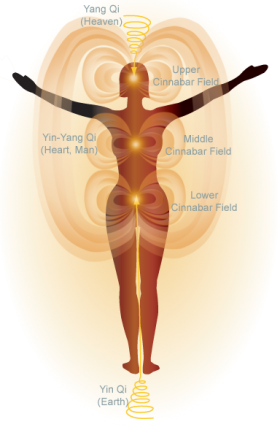Origins of Qigong
The term Qì Gōng (氣功 - meaning literally “energy work”) was fist coined in the 1950s by a famous Chinese doctor to collectively refer to a range of traditional practices of working with the Qi (Chi). These practices took different names and are known to exist from the times immemorial. The origin of them is usually attributed to healing dances (Tiao Da Shen - 跳大神 - “the dance of a great spirit”) performed by Shamans of the Northern China for healing over people and crops.
The inscriptions showing exercises similar to dance movements were found on oracle bones throughout China, Mongolia and South-East of Siberia. Archaeological discoveries of Ma Wang Dui (The Horse King’s Tomb) in Hunan province in 1973 included silk banners dated to Han dynasty (206 BC to 220 AD) with 44 exercises pictured with great accuracy. These exercises had the name Dao Yin over them:
- 道 (Dao) : “to lead, to direct” - refering to directing the Chi along the channels where Chi and Blood circulate
- 引 (Yin) : “to draw the string of a bow to oneself” may refer to the fashion in which the exercises are performed - soft and steady stretching and moving rather than abrupt and harsh motion
There are over 3000 styles and forms of “energy work” known to date and they may differ from each other significantly. For example Tai-Chi (Tai Ji Quan - 太極拳) is a martial art based on the command of the Chi, and is essentially a form of Qigong. The Iron Shirt (Tiě Shān - 铁衫) is another form of Qigong aimed at protecting the human body from impacts in a fight, and even making it strong enough to withstand hits with weapons. Some other Qigong variations, such as Bone Marrow Cleansing (Xi Sui Jing - 洗髓经) have pure medical and health-preserving goals. Some forms of Qigong are associated with a particular traditional religion - such as Buddhism, Daoism, however the exercises themselves are not bound by any religious context and driven by the very make-up of the human being, as it was known to Chinese doctors and sages.
Qigong: exercise vs healing

As an exercise, Qigong is essentially a form of dynamic movement meditation that teaches you to stay in balance within yourself emotionally and physically, develop awareness of natural rhythms and flows, and open your heart towards greater compassion to the people and other creatures. Such a deep reconnection to your environment leads to a smoother experience in whatever you do - whether it’s work, family or play. Some Qigong styles include predefined sequences or movement, while others may be spontaneous or semi-spontaneous. The spontaneous forms are known as Natural Flow Qigong.
Qigong is mostly known as an exercise routine nowadays, however it can also be applied as an external healing. This is known as “the external Qi therapy” (外氣療法 - Wai Qi Liao Fa). It involves a higher level practitioner projecting the Chi or altering its flow in the patient’s channels to remove blockages, normalise the flow and boost the activity of some acupuncture points and even the internal organs directly. It requires a significant effort in personal training, compassion and dedication to reach the Wai Qi level, however for some people it is easier than for the others. Some people call Qigong healing a “needle-free acupuncture”.
You can read more on philosophical aspects of Traditional Chinese Medicine and relationship between Qigong and other TCM modalities here.
In the class
The classes are usually held once or twice a week and suitable for all age groups. They are not too demanding physically, however some excercises work so deep on your physical, emotional and mental levels that after doing them you might feel very well worked-out. It is adviced to have some food before the class (but not immediately before) to have some spare energy to work with.
The class consists of two parts.
Yang Qigong (the mind directs the Qi and the body)

First part is a guided Qigong practice where we do some excercises together. These excercises teach you to direct your attention at the flow of energy within your body and the two major streams of Yin (Earth) and Yang (Universe) natural energies supporting you. The exercises build up awareness of the three major Dan Tian fields (cinnabar fields), help you open and cleanse the energy channels and open the gates of vitality in the body.
The excercise part is always tailored to the needs of the whole group and also comes in sync with the current rhythms and flows of the environment. You may find every new session to be unique and quite different to the previous one. This part provides a smooth transition from the world of day-to-day affairs, thoughts and patterns of movement into a special meditative state required for the second, spontanous part of the our practice.
Yin Qigong (The Qi emits spontaneously guiding the body)
Second part is a Spontaneous Qigong meditation, aiming to bring you in contact with the natural healing energy within you and the healing energy of the nature at large. Here you learn to follow and be directed by the Qi softly working its way through your energy channels from the Universe into the Earth, purifying your whole system of channels, as it is said in Chinese Medicine that “the man is between the heaven and earth”. During this part your body goes into the state of deep relaxation performing slow and highly precise movements allowing the muscular and emotional tension unbind and break free from pain and stagnation. This is a very powerful technique known as the Natural Flow Qigong or the “exercise of pre-natal Qi” referred to in the article on energy channels.
It is not uncommon to have a stubborn chronic pain gradually go away during this part and also some practitioners may have find their bottled-up emotions released - some even start crying in relief.
An important precaution is that at the end of each Yin Qigong session one must “close down” (Shou Gong - 收功) the stream of the coming energy properly. If not done, the Qi that keeps working on the body may not be properly engaged in usual daily activities. For example, one form of Qi (Wei-Qi) normally protects a person from colds, winds and infections. If not returned to the Dan Tian at the end of the practice, the Qi may not be fully available for the body to use for these purposes when required. So, make sure you conclude the session properly.
Group Healing
Group healing session is provided as a part of this Spontaneous Qigong meditation. The teacher will attend each one individually during the meditation and help to resolve current issues projecting his or her energy to release some difficult blockages and stagnation.
Tea Break
Break between two parts is necessary to have some rest and discuss whatever you may ask about your Qigong practice. We often enjoy long conversations and share a lot during this time. We have a Chinese green tea or occasionally some mild Chinese herbs during the break. Biscuits provided.
Class Information
Please contact us for class location and times.
Two parts of the class with a break take 2 about hours. Wear some loose comfortable clothing and have something warm in winter to put on afterwards. It is suggested to have some food before the class, however not immediately before - an hour before the training is the best.

